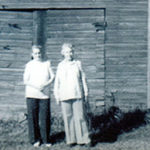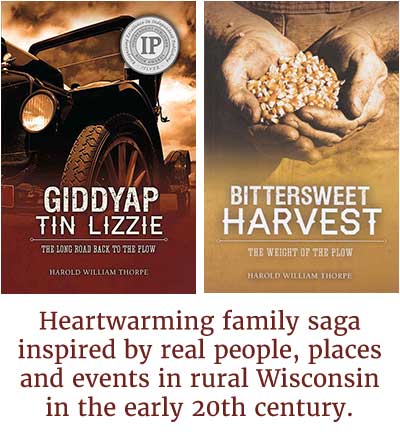If you are reading the Write Your Family Story series of articles – I can safely assume that you are interested in writing your family story. What I cannot assume are your reasons for wanting to take the time and effort to do so.
Consider Your Goals
Many books have been written that will help you craft a memoir. You only have to search Amazon.com, your local bookstore or your local library to find them.
Some books will assume that you want to write with a technique and a flair that will attract a publisher or agent. Others will tell you that writing your family story is a process of self discovery, that it’s good therapy.
No matter how talented a writer you are, attracting the eye of a publisher is a difficult road — but it is a worthwhile journey if publishing is your ultimate goal and you’re willing to commit more hours than you can possibly imagine.
If you’re that determined, how-to-write books will help you.
I don’t promise that I can help you land a publishing contract. Nor can I promise that you will discover something about yourself as you write. That depends on how much of yourself you put into it.
But I do promise that your writing can achieve family significance regardless of what form your writing ultimately takes. Whether you have a nicely bound book, a few pages printed at your local print shop, or even a few loose leaf sheets that you’ve stapled together.
Your story will be valuable no matter how you write or present it because it will be filled with the people and places of your family’s story. It’s this content that will be important in the long run.
Creating a Story that Moves
I’ve heard that people don’t read much anymore, and when they do, it’s mostly snippets and excerpts that attract them. Today’s readers like stories that move, and this suggests we should write sparsely and keep the flow of a story moving forward.
That can be done by eliminating most adverbs, reducing adjectives and prepositional phrases, and relying upon that most useful fellow — the active verb.
Passive Voice
Before getting into the details, a brief refresher on passive voice vs active voice may prove helpful.
When you write a sentence in passive voice, you construct it so that the subject of the sentence receives the action, instead of the subject of the sentence performing the action. For example, in the sentence
“The lone sheep was attacked by the wolf”
the “lone sheep was attacked,” is an example of passive construction because the subject of the sentence, the lone sheep, received the action (was attacked.)
Whereas the sentence
“The wolf attacked a lone sheep”
is an example of an active voice because the subject “wolf” is the one that performed the action.
“The word ‘lifted’ in “Ruby lifted a fork full of hay” is another example of an active verb. Whereas, “ A fork full of hay was lifted by Ruby” is passive.
Because it is objective and impartial, passive voice is a good tone to take when writing a report. But in a narrative story it creates writing that is just that – passive.
To avoid being passive, get active!
Active Verbs
The verbs that can be used in active construction are appropriately called active verbs.
Run, jump, lift, sing, write, think, play…these are all examples of active verbs.
The word “wrote” in “Catherine wrote the poem” is an example of an active verb. (“The poem was written by Catherine” is a passive construction.)
Use active verbs whenever possible in your stories. They are more dynamic and more interesting to read. Active words keep the action moving forward.
More opportunities for active verbs
In addition to changing passive sentences to active sentences, you can create more action in your writing by replacing prepositional phrases and adjectives with active verbs.
For example, it is better to say, “The dog destroyed shoes in the hallway” than to say, “The shoes under the chair in the hallway were badly chewed by the dog.” The former is more concise, more powerful, and invokes a stronger image.
Help your reader imagine the action
Do the same with concrete nouns. Readers can draw images in their mind of tangible nouns like Ruby, ice cream, or silo. Incorporate into your writing material objects that readers can see, touch, taste, or smell — objects they can relate to.
It is easy to imagine the following scene.
Ruby’s ice cream melted quickly in the sun and a large drop of chocolate fell onto the new white dress. Catherine began to cry.
Concrete nouns activate the senses. The reader can feel the sun, taste the ice cream, see the white dress.
Naming your characters in the action also helps to make the scene familiar and tangible. When you do not call out your characters by name, they are considered abstract subjects.
For example, the abstract subject in the sentence, “Many battlefield soldiers performed acts of bravery,” may evoke many images. But until we give those brave battlefield soldiers identities, we can’t put a face on the actors.
“Ruby bumped into Henry before he fell onto Catherine a second time,” lets us know exactly who did what. An abstract noun doesn’t produce nearly as tangible a picture.
Your readers will appreciate it
Passive verbs and abstract subjects are not, in themselves, grammatically incorrect. But generally, your subjects should be concrete and active — rather than abstractions and acted upon.
A story becomes crisp, and flows better, when you reduce abstract subjects and passive verbs.
Those of us who write family stories have the advantage of a built-in audience, so to speak, of family members who will likely read our stories no matter how much work we do or do not put into them. Still, your family members will appreciate your work when you write concise, interesting material.
In the next article, I’ll begin talking about the simple narrative summary anecdotes that my mother, Laura Annette Fitzsimons, wrote in her 1999 memoir, From High on the Bluff.
Next: Write Your Family Story Part 4: Details, Details.
Start at the top: Write Your Family Story Series Introduction









